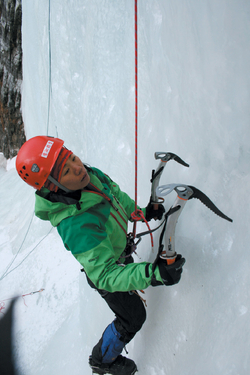 To call her Daisy would be an American thing, however her Chinese name is, 美涼 – which translates into Beautiful Cool (pronounced Mei – Liang); quite appropriate if you ask me for a woman who wants to stay up and stay challenged in the snow and ice of the world’s highest peaks.
To call her Daisy would be an American thing, however her Chinese name is, 美涼 – which translates into Beautiful Cool (pronounced Mei – Liang); quite appropriate if you ask me for a woman who wants to stay up and stay challenged in the snow and ice of the world’s highest peaks.
Traditionally, mountaineering women in Taiwan have not been a popular thing, in fact, it’s rare. Mei-Liang has transcended the stereotype of the demure, fragile, Asian girl with her sturdy and bold strength.
Reputed as a strong and solid climber, Mei-Liang has been guiding and teaching climbing to the locals in her country of Taiwan while still enjoying the chance to get out and ascend routes. Her adventures have taken her all over Asia to Europe, South America and the US. The year 2005 saw her and her party of eight women make an attempt to summit Mt. Everest – the highest peak in the world; a great risk ensued and Mei-Liang had to make the difficult decision of whether to back down with the summit in very short sight of her. In our eyes, she was a victor because she ultimately chose to live to see more days of ascents ahead of her….
The greatest uphill battle though, may be the attempt to break the stereotypes that Asian women weren’t built for this sort of strenuous activity. Mei-Liang is crushing that image and enjoying every bit of it to the top.
Deepest thanks to Uncle Ambrose, my mom and my cousin Mei-Chun for assisting me with the translations so we all can read Mei-Liang’s story.
RRRG: Where were you born and raised? Where do you live now?
Mei-Liang: All in Yilan, Taiwan (a county in the Northeast of Taiwan).
RRRG: Same with my mother’s family! Yeah! Nice to talk to a woman from the same town. :) How old were you when you climbed your first mountain? How was it?
Mei-Liang : The first time I hiked in the mountains was around 17/18 years old. I discovered it through my family; we would take trips to Jiao mountain and just trek around. It was easy hiking. I ascended my first at-elevation peak (in snow) at 20 years old. I did that participating in a climbing group at the University of Deng Shan but it wasn’t difficult hiking for me.
RRRG: Who was your mentor(s) that helped develop your knowledge and training for this activity?
Mei-Liang : Wu JinXiong was my mentor; he is the first Taiwanese mountaineer to summit Mt. Everest and he took me under his wing.
RRRG: Which type of climbing is your favorite – ice climbing, rock climbing, bouldering, alpine? And why is it your favorite?
Mei-Liang : I like ice climbing, rock climbing, bouldering, alpine…but my favorite is expedition alpine climbing; I like climbing big mountains to explore my limit.

RRRG: Please tell us the names of some mountains you have climbed? Which one was the most difficult? Which one required the most technical skill?
Mei-Liang: I’ve climbed (click on Mt. name for link to more detail): Everest (Nepal – highest peak in Asia and the world) ,
Manaslu (Nepal) ,
Denali (Alaska – US’s highest peak),
Aconcagua (Argentina -South America’s highest peak),
Island peak (Nepal),
Elbrus (Russia- highest peak in Europe),
Khan- Tengri (Kyrgyzstan-Kazakhstan broder) and Bogda (China – highest peak in the Bogda Ola Range)
….the most difficult though was Everest and Manaslu. Bogada required the most technical skills.
RRRG: How many women were on your team for Everest? How did you get chosen to be on the team?
Mei-Liang : Nine women. We went through an extensive selection process to become qualified for the team…this included physical assessments, various interviews – all before an experienced medical team and other mountaineering specialists.
RRRG: What was your experience when you climbed Everest? Please tell us the story:
Mei-Liang : When I was hiking above 7,000m (about 22,965 feet), I wasn’t confident that it would be safe for me to come down by myself from the top. Therefore, I decided to turn back and come down with the rest of my party. It was about 7800m (25,590 feet) when I decided retreating would be the best and safest option. I wasn’t sure if a solo descent was possible to survive after I had reached the top.
Before our next attempt to conquer the summit, our whole team decided to descend and rest at Tingri for a couple of days. I got food poisoning there and suffered fever and diarrhea for two days. I was still struggling with the food illness when we moved to the base of Everest in preparation for another attempt. I wasn’t eating well and was in terrible physical condition but still, I went with the team to ABC (Advanced Base Camp, aka Camp III at 7,200m – about 23,621 feet) waiting for the weather to clear up to permit our hike. I knew I was in bad shape and was coughing a lot but didn’t realize how terrible my condition was until we were moving along the steep, icy cliffs from ABC camp to C4 (Camp IV at 7926m – 26,000 feet). I wasn’t moving at the regular speed, I felt very weak and was coughing nonstop; not to mention, I didn’t sleep well that night at all. The next morning, the persistent cough and the pain from both sides of my rib cage made me wonder if I should continue with this journey.
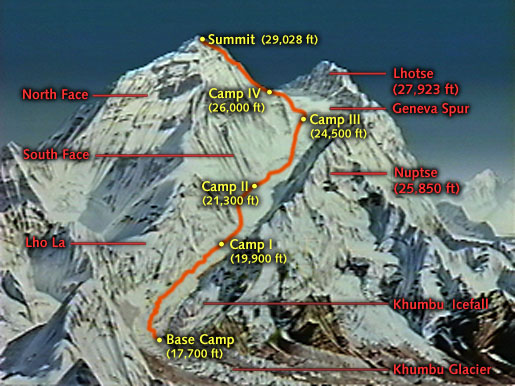
Mt. Everest elevation map
There wasn’t anyone to assist me in this hike and we also had a limited oxygen supply once we are over 8,000m (26,246 feet). If I can’t make it to the top on my own and have to descend to a lower elevation all by myself, I wasn’t sure it would be practical or even possible. It gets very dangerous there when you have to be alone working your way down.
The higher I went, the worse my body would get. I knew I was also exposing myself to altitude sickness (in addition to being ill from the food). Because of all these factors, I was debating with myself while I continued up. I could just see the peak of Mt. Everest right there in front of me and it felt as if the 2-month effort would finally result in success.
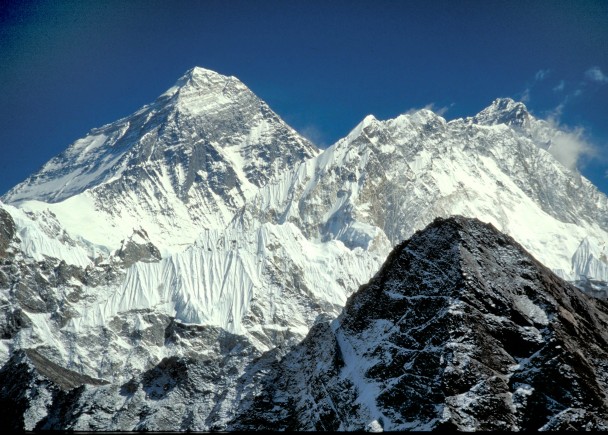
Deciding to give up seemed much more difficult than deciding to go forward. In my head, I heard “the mountain is always there”. Ultimately, I decided risking my life was not something I wanted to take and I hiked down. I didn’t want to gamble my luck, getting severe frost bite or my life. There are still so many mountains I would like to conquer and I didn’t want to impair my ability to climb in the future.
On the way down, I met a team mate who was very ill and helped him hike down. Without my assistance, he might not have been able to make it down alive. Although I didn’t make it to the top, it was a great reward that I was able to assist him. Since then we have built an unconditional friendship. It seemed meant to be that I didn’t summit so I could help keep him alive.
RRRG: What was your training like for Everest? Or for any mountain? What kind of training do you do to prepare yourself?
Mei-Liang : Usually, I rock climb, hike, bike and run in Taiwan. I train in ice climbing every year in South Korea, France and China.
RRRG: Are there many females/girls that climb in Taiwan?
Mei-Liang: Not a lot … but there are some.
RRRG: Who are some of your heroes?
Mei-Liang: Messner, Krzysztof Wiekicki, Gaston Rebuffat, Denis Urubko /Anatoli Boukreev, Yasushi Yamanoi
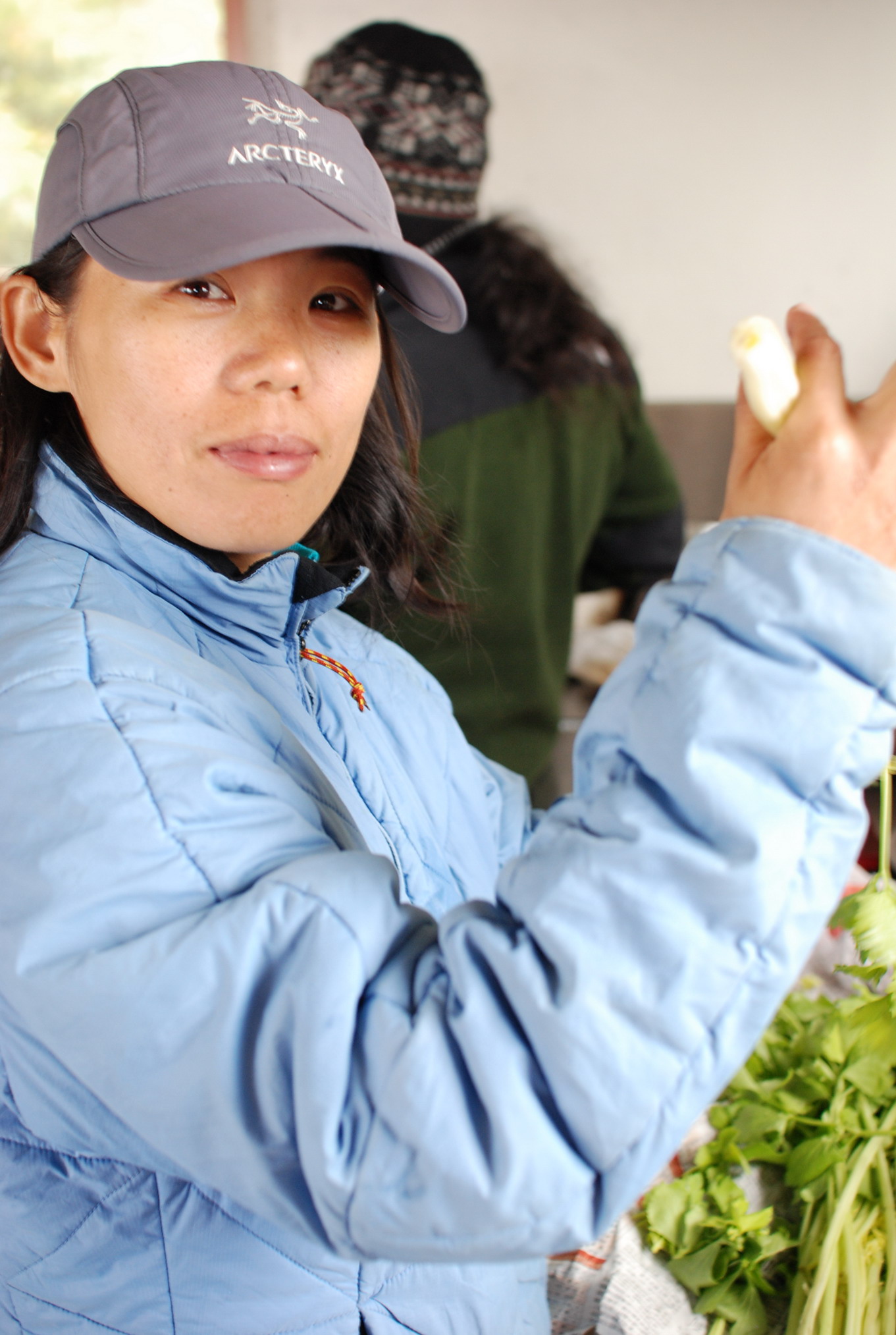
RRRG: Does your family get worried about you mountaineering? Do they support your passion?
Mei-Liang: Yes. They always worry. Some family members don’t support my passion but it’s because they are very worried for me and don’t like me participating in this sport; especially my parents. Half my brothers and sisters are supportive. But in 2005, when I climbed Mt. Everest, my parents were actually very proud of me.
RRRG: What was it like to always climb around men? Do they treat you nicely?
Mei-Liang: Not very different or noticeable. I am happy climbing with men. They treat me nicely; in fact, they never think I am weak. I actually have more experience than most male Taiwanese climbers. Most of time I am stronger than men in alpine and ice climbing.
RRRG: Do you think more girls in Taiwan are starting to like climbing/mountaineering now in 2010?
Mei-Liang: I am not sure.

RRRG: Have you ever had a scary moment during hiking on a mountain? Please tell us what happened and how you were able to solve the issue and feel comfortable.
Mei-Liang: Yes, recently (last year) we climbed Manaslu in the Himalayans. This mountain is 8163m (26,781 feet) high and has always been troublesome with bad weather and avalanches; just full of potential dangesr. Last year during our way up to the peak of the mountain, my team and other teams encountered persistent snow storms; strong winds and non-stop snow. Most of the tents at camp were buried by the heavy snow. The trail disappeared because it was completely covered and the path was blocked off/ Without any options, all the teams had to immediately turn around and come down. Coming down was extremely dangerous; besides the difficulty of walking in strong winds and deep snow, searching for the invisible hiking path was nearly impossible. Our fears were greatly heightened because of the extreme avalanche risk above our hiking trail. There were a few small avalanches nearby which increased our worries of encountering one ourselves. All we could do was stay calm and come down step by step. We couldn’t afford even a minor set back that would delay our progress.
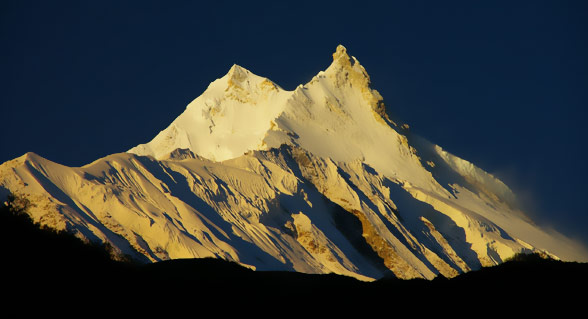
Manaslu – in the Himalaya mountain range
RRRG. If you can’t get to the top of the mountain, do you feel sad or disappointed? What are your thoughts if something might be too dangerous or some emergency happens and you don’t get the summit?
Mei-Liang: I have been partaking in expeditions about 15 years and have climbed over 20 high-altitude mountains. I have some failure experiences and there are even some ascents that I have tried twice. Honestly, if I can not summit, I feel pitiful and a little disappointed but I think about safety. I think about all of our members’ safety and that is the most important for me.
RRRG: What is the most important advice you can give a young girl who wants to climb “at-elevation” mountains?
Mei-Liang : You must be in good physical and have a strong mind – it’s also great that you have experience in mountain hiking and those environments. If in Taiwan, I will suggest that you practice on mountains over 3000m and then gradually more as you get stronger.
RRRG: What do you do now for work?
Mei-Liang: I am mountain guide and rock climbing instructor. I also write for Chinese mountain magazine.
RRRG: What are your future goals (personal and hiking)? Do you have more mountains you would like to climb?
Mei-Liang: I’d like to focus on climbing more mountains in the Himalayas or in Tien-Shan (China) or in the Alps. Also, I want to continue guiding and conditioning young people for mountaineering and rock climbing.
RRRG: Do you have any sponsors or family/friends you would like to thank or say hello to?
Mei-Liang: Thanks my family and all of my friends. Thank you so, so much!

—————————————————————–
Interview in Traditional Chinese:
喊她 黛菊(Daisy)是美國人的事。 她的中文名叫美涼(意謂美麗的涼意 發音為Mei-Liang)相當貼切 反映一位女性意願挑戰登上冰雪中的世界最高峰。
傳統上,在台灣攀登高峰女性並非普遍,事實上是稀罕的。美涼以也她不屈及勇敢的優勢已超越 亞洲女性靦腆 而纖弱的窠臼。
享有風評為強壯結實的登山者,美涼引導及教育在台灣的國人在地人士攀登山頭,同時享受機會外出及攀登路程。她冒險遍及亞洲至歐洲,南美及美國。2005年她及她的八人團隊企闔攀登聖母峰-世界最高峰-的峰頂;確定為一大風險以及美涼須困難的決定是否自近在眼前的峰頂撒退。在我們眼前,她是位勝利者,因為她最終選擇存活觀看往前更多天數的攀登。
即今最偉大的艱辛戰役,為企圖打破傳統老套;亦即亞洲女性過去並非被建立在此類需奩鬥的活動。美涼粉碎該形象並享受每寸攻頂的樂趣。
———————————————-
RRRG: 您在那 裡出生? 成長?現住何處?
李美涼: 宜蘭
RRRG: 您第一次登山幾歲? 請告知該次登山如何進行? 是否困難? 或容易? 是否身体不適?
李美涼: 17.18歲 時跟家人一起爬郊山. 這次像郊遊, 容易.
20歲第一 次爬高山(雪山), 參加大學登山社活動,不困難, 但第一次背重裝滿辛苦的. 身體很Ok 沒有任何不適.
RRRG: 您如何開始登山? 如何發現登山,以及誰是您的導引者或英雄偶像?
李美涼: 大學時參加登山社開始登山
導引者~ 登山社的指導老師—吳錦雄 (台灣第一位登上Mt.Everest)
RRRG: 誰是你心目中的英雄?
李美涼: 李美涼: 義大利登山家Messner 梅斯納, 波蘭登山家 Krzysztof Wiekicki, 法國登山家Gaston Rebuffat, 哈薩克登山家Denis Urubko /Anatoli Boukreev, 日本登山家~山野井泰史
RRRG: 您喜愛的登山類型? 如攀冰, 攀岩, 攀礫,登高峰?
李美涼: 冰攀.攀岩.海外遠征我都喜歡,我最喜愛的是海外遠征,因為我喜愛攀登大山、喜歡冰天雪地。
RRRG: 請告知 您登過的山? 最難的是那一座? 那一座最需技巧?
李美涼: 聖母峰.馬納斯鹿峰.北美洲最高峰-麥肯尼峰.南美洲最高峰-阿空加瓜峰.喜馬拉雅山-島峰.歐洲最高峰-厄爾布魯斯峰. 天山-漢騰格里峰.天山-新疆博格達峰
最難的是—聖母峰. 馬納斯鹿峰
最需要技巧的是—博格達峰
RRRG: 登聖母峰 – 埃弗勒斯峰 – 在您們團隊有幾位女性? 您如何被選進該團隊?
李美涼: 9位女性
– 先報名 審核資歷,再經過評審委員面試審核。
RRRG: 當您登 上聖母峰峰頂時,您有什麼樣的体驗? 您腦海中有什麼想法?
李美涼: 我並沒有登頂,攻頂時我在大約7800公尺處決定下撤。當我一個人走在七千公尺以上登頂路途,當時我沒有把握我可以一個人平安的下來, 所以我決定下撤。
登頂前我們全隊下撤到定日休息數日,我在定日吃壞東西,發燒腹瀉二天,回到聖母 峰基地營準備登頂時,我仍腹瀉無法吃東西,身體狀況極差,體力消耗很大。我仍是隨登頂隊伍上到ABC前進基 地營,等待好天氣就展開攻頂,當時我一直咳嗽不舒服,雖然知道自己的身體狀況不如之前。但真正從ABC 6500m上到北坳營地(C4 7028)這段陡峭的冰坡時,才真正發覺自己的身體狀況不好,速度比之前高度適應時慢了二個小時,而且 身體非常虛弱和不舒服,仍一直咳嗽,當天晚上幾乎沒有睡覺。隔天繼續往上時,體力雖感覺還可以,但仍一直咳嗽,且二側肋骨隱隱作痛,這 情形讓我開始認真考慮是否不要再上去了。
因為身旁沒有任何協作或隊員,只有自己一個人,又考慮到八千米以上我們的氧氣分 配的數量有限可能不夠,若完全要靠自己一個人登頂下撤,我沒有十足的把握。若有任何狀況,又沒有任何人陪同的情況下,實在是滿危險 的。
另一方面,我考慮到自己的身體狀況並不好,越往上身體的狀況可能越差,甚至也可 能轉往嚴重的高山病,但上面並沒有任何隊員可以協助下撤。

基於這些種種考量,我再往上的路上不斷反覆思考,不斷質疑自己的考慮是否正確, 眼看聖母峰就在前方,眼看二個月來的努力就差一點點,要決定下撤比決定繼續往上還難,心裡有著很沉重的掙扎。「山永遠在那」心底響起 這句話,最後我決定下撤,我並不想賭運氣,我還想爬其他很多山我還想攀岩,我不想賭上生命或賭上手腳凍傷。
下撤途中遇到一位病情嚴重的隊員,我協助他慢慢的往下撤,如果沒有人幫忙,他可 能下不了山,雖然沒登頂,很高興我幫助了他,我們也因此有了生死相交的情誼。
RRRG: 登聖母 峰有什麼訓練? 或登其他任何山? 您以何種型態的訓練來自我準備?
李美涼: 登聖母峰前二年我就一直在登山,且一直維持平常的基本體能訓練,一星期攀岩2~3次,跑步或騎單車3~4次,冬天到 韓國及法國冰攀訓練;出發前一個月更特別前往法國阿爾卑斯山耐寒訓練,及冰雪攀強度訓練。
RRRG: 在台灣 有很多女性登山嗎?
李美涼: 有一些人但不算多.
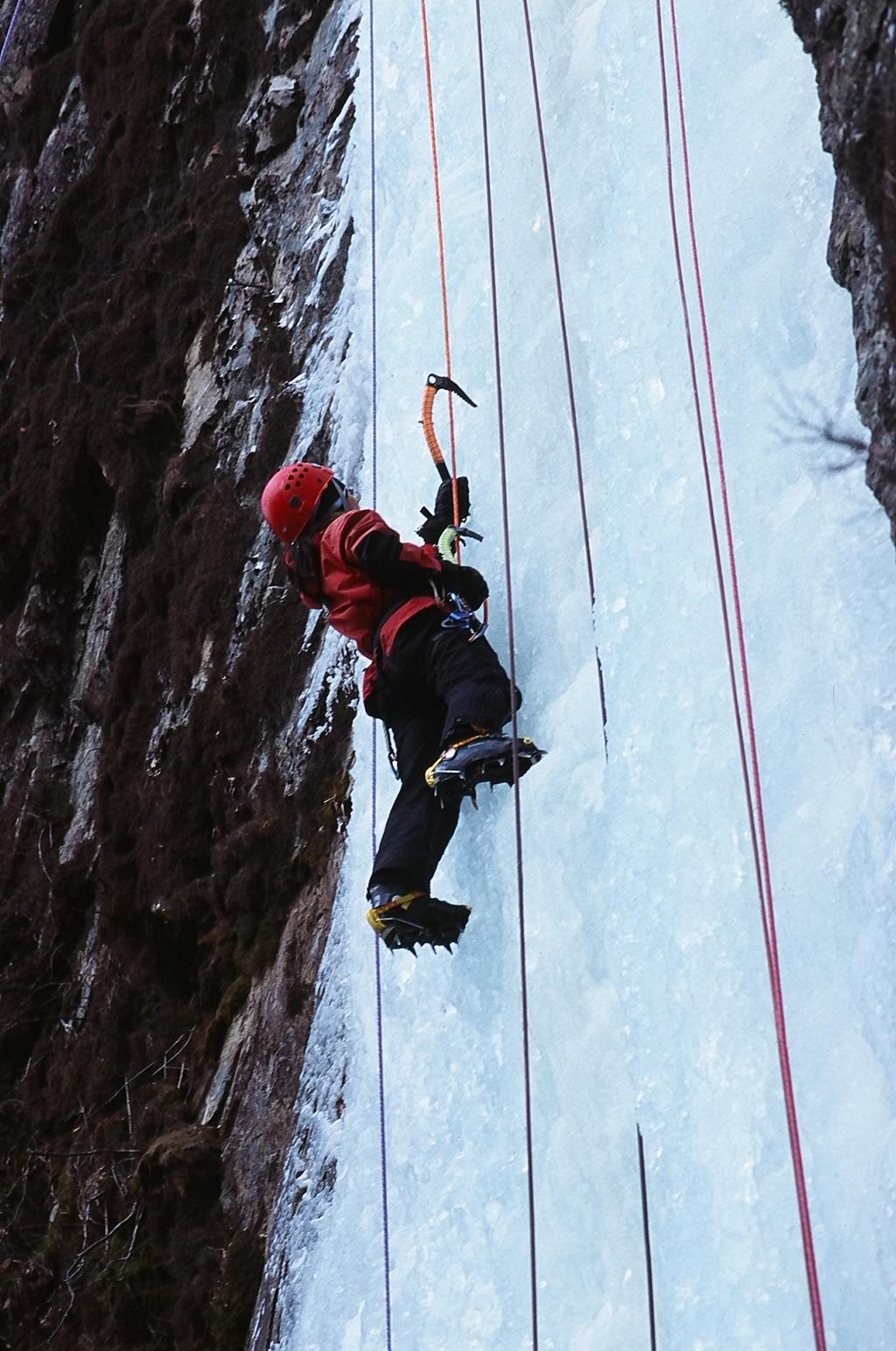
RRRG: 你的家人擔心嗎?
李美涼: 我的家人一直都很擔心我,特別是父母親一直希望我不要再爬山,兄弟姐妹 則各半,有人贊成支持,有人不贊成。
但…2005年我攀登聖母峰時,父母親卻很以我為榮。
RRRG: 圍繞在男 性中登山像什麼? 他們善待您嗎? 他們是否認為因為您是女性 您不夠強? 他們整您嗎?
李美涼: 不管是海外遠征或海外冰攀活動隊員大多是男性,且經常是只有我一位女性。我很習 慣和男性一起登山冰攀,他們都對我很好,跟他們爬山很快樂,沒有任何因為性別的不愉快或不一樣。
過去有許多的海外登山或冰攀活動,是由我擔任領隊負責規劃組職活動,男 性隊員們應該不認為我比他們弱。相反的因為我比多數的男性隊員有更多海外登山及冰攀經驗,我的體能狀況和高度適應狀況,多是比他們來 的更好。
RRRG: 在2010年,您是否認為在台灣有更多女 性開始登山/登山活動?
李美涼: 總體人數是否增加,這我不確定.
RRRG: 在登山過 程中有過恐懼的時刻嗎? 告訴我們發生的事, 以及您如何解決難題和感到舒解?)
李美涼: 有的, 最近一次就是去年攀登馬納斯鹿峰,這山海拔8163公尺,這山一直以來就是以壞天氣及雪崩頻 繁,充滿潛在的危險性。
去年就在我們攻頂階段,我們及其他隊伍都遭遇連續暴風雪,風很強雪下個不停,許 多高地營的帳棚都被雪埋掉,路線完全被大雪覆蓋不見了,暴風雪完全阻絕了登頂的路。所有隊伍都不得不緊急下撤,下撤過程中也是驚險萬 分,除了強風雪深難走之外,因為路線完全被雪覆蓋,得小心找路開路,最可怕的是路線完全在雪崩區,附近亦有一些小雪崩,不 知道會不會遇到雪崩?心裡確實很緊張害怕。但只能穩住自己,一步一步慢慢的下撤,不能有任何出錯。
RRRG: 假如您未 能攻頂山峰,是否傷心或失望? 假如 因為太危險或緊急事故發生,致無法攻頂,您想些什麼?
李美涼: 過去我有許多失敗的經驗,有一些山我都是第二次才成功,對我而言沒有一座山是絕 對100%會成功的,天氣運氣的影響佔了一大部份,所以若沒能登頂,我雖然會感到遺憾失望,但不會太難過或傷心。
若因危險或緊急事故發生而無法登頂,通常遇到這樣的狀況,雖然決定繼續或下撤會 很掙扎很困難,但思考各種可能之後,我的決定會是很快的,而一旦決定下撤,我就不會再猶豫或遺憾,會快速專心的下撤。
RRRG: 假如 有一年輕女孩想要登四仟多公尺高峰,什麼是您能給的最重要忠告?
李美涼: 一定要有好的體能,上山前要多作運動訓練
若是在台灣則盡量多爬一些百岳(超過三千公尺以上的高山),對 於體能、登山經驗、心理適應、高度適應都很有幫助。
RRRG: 您從事 何種工作?
李美涼: 我現在是一家戶外公司負責人,我的主要工作是登山嚮導及攀岩教練。
RRRG: 您未來 個人和登山的目標, 是什麼? 您是否想要登更多的山?
李美涼: 未來我仍希望可以爬更多的山,特別是高海拔的山
另一方面,我希望能帶領更多的年輕人登山或攀岩,也希望帶領更多青少年走進山 裡,從事各種戶外活動。
RRRG: 您是否想 跟任何贊助人或家人/朋友打招呼?
李美涼: 謝謝我的家人及朋友,也謝謝曾經贊助過我的廠商。



美涼,真佩服….keep move…